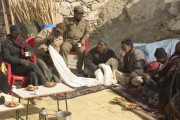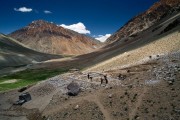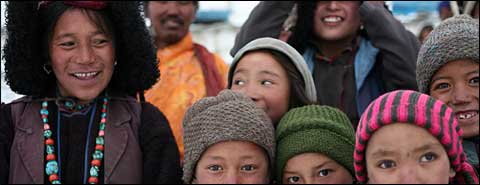Kargyak is expecting school, team Surya is back home
After five weeks spent in the adverse weather conditions of the winter Himalayas, the NGO Team Surya has returned home. They even recovered from severe sickness which required a helicopter transport to the hospital. Despite the problems, the goal of the expedition has been fulfilled. The wood for the construction of the environmental school in the village Kargyak is ready. Fifty children are enrolled in the school and the glasshouse (greenhouse) is flourishing in the middle of the snowy mountains.
The team Surya was pleasantly surprised by the activities of the villagers. They started to pull the poplar wood up the frozen river upwards to Kargyak. Thus, they expressed clearly that they are highly interested in the school construction and that they are ready to help with its realization. We had to accurately determine the size of the load and its quality because the load was bought by villagers in the autumn. 'The accurate data will make it possible to elaborate on the construction project.' The wood quality is variable and we had to explain to the locals why they couldn't cut the wood in the middle to make their work easier.' Explains the head of the Surya team Honza Tilinger. Duly, for the construction will require 6 meters long baulks for the construction.
The Surya team was interested in seeing how the villagers are taking care of the greenhouse that the team had helped them build last summer. Jára Pecháček says it works perfectly. The locals have achieved three harvests since October. They cultivate spinach, coriander, and radishes. The village has fresh vegetables in the middle of winter Himalayas. 'The women take care of everything very carefully. The entire valley is talking about it and all the villages around want to have the same glasshouse, too', Jára tells us.'
A data logger was placed in the greenhouse and it has collected the temperature and humidity data from the inside and outside of the greenhouse. 'The data is very useful because till now, no measurement was done in this area except that of Granny Stendzin who states she has recently begun to wear her yak coat in October instead of September, as in the past. Honza states "The other data logger was placed in one of the traditional houses recently."
The other goal if the expedition was to find out how many children will attend the school. The Memorandum of Understanding between the team and the surrounding villages was drawn up because the school will be attended not only by the children from Kargyak but by the other children from entire upper part of Lung-nak valley, also. Parents from other villages are interested enormously in sending their children to our school; many did agree to help with the school construction. The nearest village Schi offered the same collaboration on the school construction as the village of Kargyak did before. Thus, they will be willing to work on the construction site for several days a year.
The villagers are still interested in the schools' construction. The locals celebrated the arrival of the team along the frozen river (chadar) by fine food and drinks (If it is possible to so-call the rest of their stocks in the end of the winter). 'They are very proud, that they were able to maintain the greenhouse and they appreciate the fact that we made so hard and dangerous a trip to visit them.' Jára tells.
The men confess the chadar vas extremely grueling. 'The Himalayas in the winter are an unbelievable experience. We appreciate the worth of the equipment we got from our sponsors. Despite the fact that the locals are comfortable using woolen coats and common shoes, we were very happy with our jackets from Humi and the lower layers from Moira', Honza tells us. During trip along the frozen river the men slept in neighboring caves, where the temperature reaches -25 °C.
'The equipment for the mountain expedition is tricky to select' explains Jára. We needed naval bags (to protect our sleeping bags against humidity in the case of ice rupture), shoe picks to keep our grip on the ice, shovels, and probes in case of a snow slide. Also the suns intensity shouldn't be underestimated. We had to wear good sunglasses, face-guards and use sun block cream was a necessity. We would like to give thanks to the climber Martin Minařík for lending us a satellite phone that helped us to call for help in a critical situation.
Our team is much occupied after the return from the Himalayas. We need to gain more financial support for our project. We have organized a benefit performance in March at A Studium Rubín in Prague, in the beginning of April we opened a photographic exhibition in cafe 3+1, and in May we will start lectures and projections in Cross Club. We will finalize the project on the basis of the new climatic data and wood parameters also organizing the team of volunteers that will leave for Kargyak in May. The ice will start to melt soon in Himalayas and we will start to create the foundations for the school.

 In now days are hppening big changes in Jammu and Kashmir.
https://www.bbc.com/news/world/asia/india
In now days are hppening big changes in Jammu and Kashmir.
https://www.bbc.com/news/world/asia/india  On September 21st, Kargyak Sun School will celebrate the 10th anniversary of its opening. There, in one of the last places on Earth, the original Tibetan culture survives at the elevation of 4200 m. Before the school opened, the village of 200 heads had only 10 members who could read and write a little. To get an education, children were sent away to boarding schools in faraway towns. Today, the Sun School has its alumni and thanks to the project, people stopped moving away from the village.
On September 21st, Kargyak Sun School will celebrate the 10th anniversary of its opening. There, in one of the last places on Earth, the original Tibetan culture survives at the elevation of 4200 m. Before the school opened, the village of 200 heads had only 10 members who could read and write a little. To get an education, children were sent away to boarding schools in faraway towns. Today, the Sun School has its alumni and thanks to the project, people stopped moving away from the village.  PRAHA 22.11.2018 | 19:00 Betlémská kaple
BRNO 21.11.2018 | 19:00 Milosrdní bratři
PRAHA 22.11.2018 | 19:00 Betlémská kaple
BRNO 21.11.2018 | 19:00 Milosrdní bratři 


